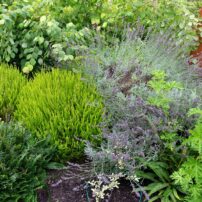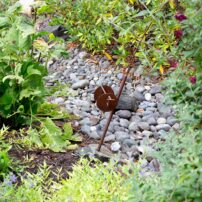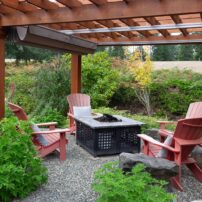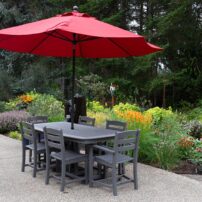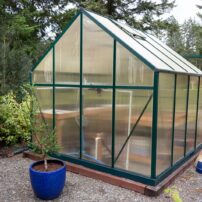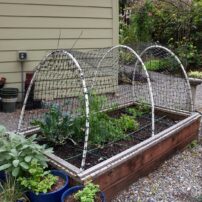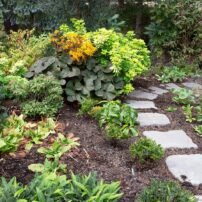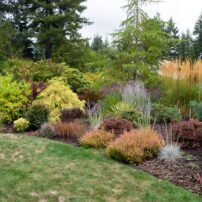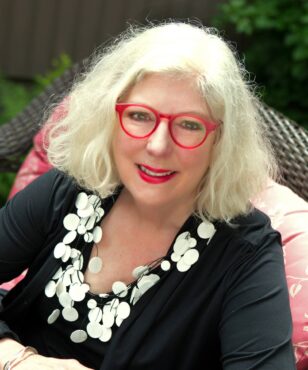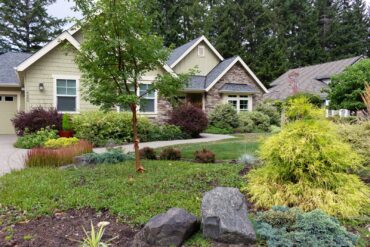 Sometimes moving into a planned community poses challenges for a gardener. There are homeowner association (HOA) rules, smaller lots and restrictions for fences, and if the lot happens to be on a golf course, that just adds to the puzzle. Master Gardener Linda Broun embraced these constraints, even celebrated them, as she created a garden that feels like an estate, not a just lot in a development.
Sometimes moving into a planned community poses challenges for a gardener. There are homeowner association (HOA) rules, smaller lots and restrictions for fences, and if the lot happens to be on a golf course, that just adds to the puzzle. Master Gardener Linda Broun embraced these constraints, even celebrated them, as she created a garden that feels like an estate, not a just lot in a development.
Seven years ago, Broun and her late husband, Mike, designed their house in McCormick Woods. “I was brain dead by the time I was done with the house, so I worked with Karen Chapman of Le Jardinet Garden Designs,” she said. “She wanted to focus on plant textures and I loved that.”
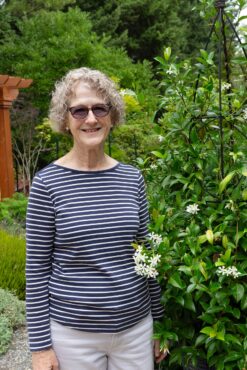
The house is located on the golf course, protected from the greens by a slight elevation filled with native plantings. “We have to maintain those plantings and we can’t replace them,” Broun explained. “All of our garden plans had to go to the HOA for approval, including the backyard. With the exposure to the golf course, we had to be really careful.”
Garden designer Chapman took into consideration all these elements, creating a dry creek bed with river rock separating the golf course from the garden. This design decision provided a defining element, allowing drainage while encouraging a sense of privacy.
Tucked into a far corner of the garden is a covered seating area with a fire pit with retractable canopy over the gazebo made by Amish Country Gazebo, allowing for year-round use and shielding bright sun from visitors’ eyes.
“Because it faces west, the canopy and gazebo provide shade and it is so comfortable. The canopy is easy to put in place using a simple crank,” Broun said. “I really wanted a gazillion seating areas so there would be many ways to enjoy the garden. Of course, the gazebo is a focal point, but I also have a bistro table and chairs on the front porch, and tables and chairs on my back patio. What I really love most is going into my green house and sitting in there all year-round.”
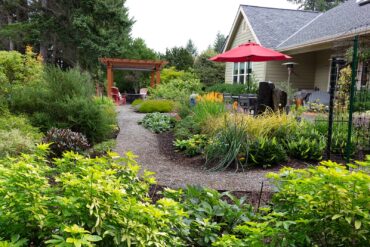 Since Broun is truly a gardener, she does her own propagation. Mike Broun built the automatic watering system and there is a sink in the space. “In the winter, I am able to keep the greenhouse at 50 degrees and I have a fan,” Broun explained. The greenhouse is beautifully tucked into the side of the house, hidden by a column of evergreen shrubs, out of the eyesight of neighbors.
Since Broun is truly a gardener, she does her own propagation. Mike Broun built the automatic watering system and there is a sink in the space. “In the winter, I am able to keep the greenhouse at 50 degrees and I have a fan,” Broun explained. The greenhouse is beautifully tucked into the side of the house, hidden by a column of evergreen shrubs, out of the eyesight of neighbors.
Privacy is a key point of this garden. As you drive up to the house, you almost miss it as it’s hidden by tall Karl Foerster grass in the summer, as well as a small meadow black-eyed Susan flowers. Shaking her head and laughing, Broun said, “But, this year, the deer ate all the flowers; I have to think of something else to put there.”
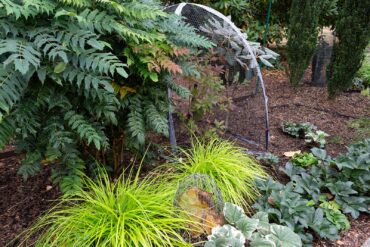 Fences are not allowed in this neighborhood. If neighbors have dogs, they use an invisible fence or create a discrete kennel. Because of the lack of fencing, deer roam freely. In one area, Broun said the deer used a passageway between her neighbor’s backyard and hers “like a freeway.” So she engaged Greg Cox of RMG Handyman to create a unique privacy screen out of old wine bottles, which serves to deter the deer and give protection between the two properties. Mike and Linda Broun were wine lovers and collectors: The screen also pays homage to the passion they enjoyed together.
Fences are not allowed in this neighborhood. If neighbors have dogs, they use an invisible fence or create a discrete kennel. Because of the lack of fencing, deer roam freely. In one area, Broun said the deer used a passageway between her neighbor’s backyard and hers “like a freeway.” So she engaged Greg Cox of RMG Handyman to create a unique privacy screen out of old wine bottles, which serves to deter the deer and give protection between the two properties. Mike and Linda Broun were wine lovers and collectors: The screen also pays homage to the passion they enjoyed together.
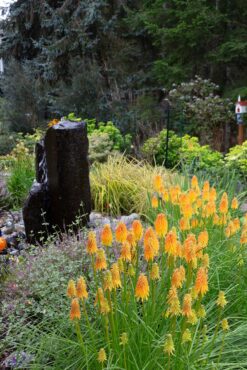 When asked more about her deer nuisance, Broun said, “I am learning to live with the deer and use deer repellent. You just have to be very, very consistent, and I change up what I am using so they don’t become used to one type. You have to be dedicated, and I attend to the repellent about once a week. With all the development, the deer population has been driven out of the forest and there is huge deer pressure.”
When asked more about her deer nuisance, Broun said, “I am learning to live with the deer and use deer repellent. You just have to be very, very consistent, and I change up what I am using so they don’t become used to one type. You have to be dedicated, and I attend to the repellent about once a week. With all the development, the deer population has been driven out of the forest and there is huge deer pressure.”
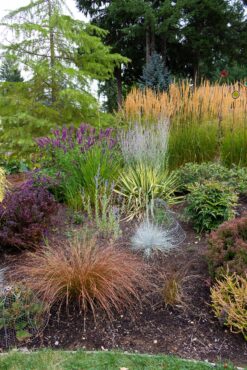 Prior to her retirement, Broun was a nurse, and she believes that there is a lot in common between nursing and gardening. “You have to have TLC with people and with plants. You try to restore both to health and do a lot of nurturing,” she said.
Prior to her retirement, Broun was a nurse, and she believes that there is a lot in common between nursing and gardening. “You have to have TLC with people and with plants. You try to restore both to health and do a lot of nurturing,” she said.
When asked about how gardening affected her during grief, she said, “I am a spiritual person and tending to the soil and plants gave me peace and a sense of connection with Mike.” Not only did Mike Broun create the greenhouse, he also built several raised beds, dug the holes and picked up Linda’s tools when she was through for the day. “Mike would say I am the gardener,” she said.
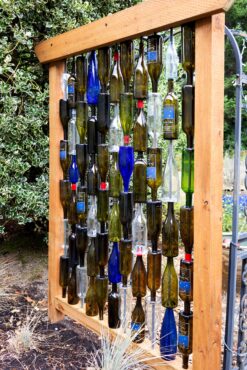 Broun has been a Master Gardener since 2011. To become a Master Gardener, she applied to the Washington State University Kitsap Extension, took classes once a week January through mid-April and fulfilled 50 volunteer hours in different areas — the WSU office, garden clinics, farmers markets and community gardens.
Broun has been a Master Gardener since 2011. To become a Master Gardener, she applied to the Washington State University Kitsap Extension, took classes once a week January through mid-April and fulfilled 50 volunteer hours in different areas — the WSU office, garden clinics, farmers markets and community gardens.
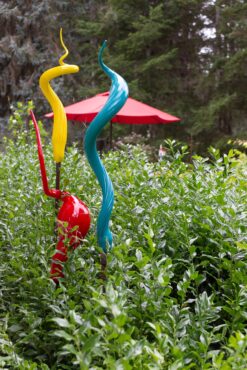 “It was a great way to give back to my community,” she said. “Some of my best friends were in the course and I learned so much. There is a great bond between people who love gardening.”
“It was a great way to give back to my community,” she said. “Some of my best friends were in the course and I learned so much. There is a great bond between people who love gardening.”
When reflecting upon how her garden developed, Broun shared remembrances of the landscapers, Father Nature of Tacoma, coming in to do the irrigation, hardscaping and soil amending to lay the foundation for her garden today. Yet, she doesn’t let the garden become stagnant.
“The more I live in the garden, the more I learn what needs to be where,” she explained. “The situation changes; our climate changes. Things that were working five years ago are not working anymore. There is constant editing.”
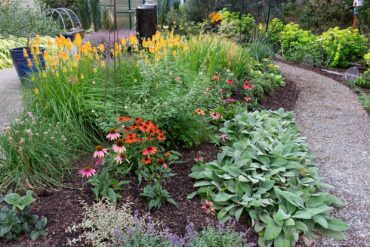 By editing, Broun means that she goes around every October and figures out what needs to be moved. She makes a list and decides where to move the plants. She is a proponent for moving plants in November because “it is usually the wettest time of the year and it is nice to get the plants in ground when it is moist, before it freezes, to let the roots grow and establish themselves.” She keeps notes about her garden and recommends all gardeners do the same because “you are going to kill a lot of plants.”
By editing, Broun means that she goes around every October and figures out what needs to be moved. She makes a list and decides where to move the plants. She is a proponent for moving plants in November because “it is usually the wettest time of the year and it is nice to get the plants in ground when it is moist, before it freezes, to let the roots grow and establish themselves.” She keeps notes about her garden and recommends all gardeners do the same because “you are going to kill a lot of plants.”
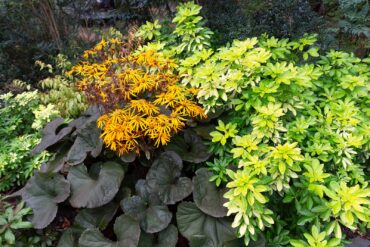 “It just happens,” she said. “It is all an experiment. When I kill a plant, it is just another trip to the nursery.”
“It just happens,” she said. “It is all an experiment. When I kill a plant, it is just another trip to the nursery.”
Broun’s garden is a work of art for people, the plants, bugs and birds. She says, “When I see hummingbirds, butterflies, birds in the garden … and they drink from the fountain — my fountain — and when I see my Alliums covered in bees, I feel like I have accomplished something, a garden with lots of benefits to the whole environment.”




